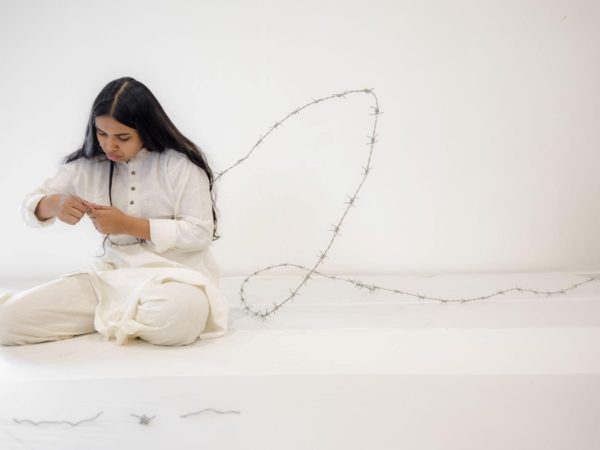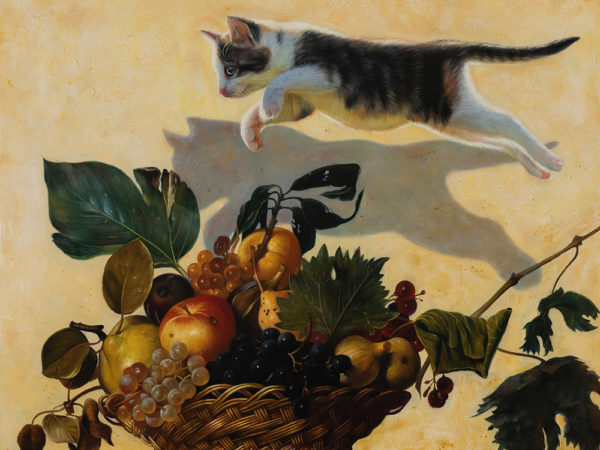Viraj Khanna (b. 1995, Kolkata, West Bengal, India) is a visual artist from India who primarily works with the medium of textile. He studied Business Administration at the University of Southern California, Los Angeles in 2018. Khanna’s works have been exhibited in solo shows at the LOFT, Gallery Art Exposure, Kolkata (2021); Tao Art Gallery, Mumbai (2022) ; the India Art Fair (2023) and recently at the National Gallery of Modern Art Mumbai (2023). He is currently pursuing his MFA at the Art Institute of Chicago.

SP: You experiment with a wide range of mediums and techniques. How does your creative process differ when working with different mediums? Are there any unique challenges or advantages you find in each medium?
VK: Experimenting with various art forms keeps my creative journey exciting. My transition to becoming an artist began unconventionally. I graduated with a business degree from the University of Southern California in 2018, and thus I was more inclined towards the business side of our family’s fashion company. The turning point happened during the lockdown when our Instagram needed content. In a spur of creative inspiration triggered by a sibling dispute, I began crafting collages using hundreds of old fashion magazines lying around at home.To my surprise, this artistic endeavour caught the attention of Art Exposure India in Kolkata through Instagram. The gallery’s director, Somak Mitra, reached out and invited me to showcase my work. Since then, I’ve participated in several solo shows with Art Exposure India and Tao Art Gallery. Initially advised by Somak to keep my art and fashion identities separate, I ventured into sculpture and painting avoiding textile. Regardless of the medium, my creative process consistently starts with small paper collages, akin to blueprints, which guides the creation of sculptures or paintings.
Embarking on experimentation, I’ve recently delved into working exclusively with textiles, particularly embroidery. Drawing inspiration from my upbringing surrounded by intricate embroidery in West Bengal. I blend traditional techniques with contemporary flair to express my artistic visions. Working with embroidery has been the most natural for me. The innumerable materials available to experiment with, alongside my experience with the practice makes it preferable as a medium to express my artistic visions. I am able to convey different emotions using the diverse availability of materials and techniques more efficiently.

SP: Growing up in a family with such a strong connection to the fashion industry, how has your family background influenced your artistic journey?
VK: Growing up in a family deeply connected to the fashion industry, particularly in West Bengal, has profoundly influenced my artistic journey. While my initial role in the family business was not directly tied to the creative aspects, my exposure to the finest embroidery work and skilled artisans shaped my artistic sensibilities. Interacting with karigars (artisans) and observing their meticulous work instilled a visual sense of quality in me that takes years to develop.
Shortly before the lockdown, I found myself overseeing the embroidery department of our family business. This role involved pricing different samples crafted by various karigars. Engaging in the continuous cycle of approvals and rejections and assigning different values to each piece became a direct and immersive learning experience. This hands-on involvement significantly contributed to my understanding of diverse techniques and the nuanced quality of traditional Indian embroidery styles like ari and zardosi. These experiences have played a pivotal role in shaping my artistic perspective
and approach.

SP: How has the technique of collage been incorporated in your work? How does it help your artistic process?
VK: The incorporation of collage into my artistic process serves as a foundational element in creating intricate structures within my works. Unlike using collage solely as a visual reference that leads the mind elsewhere, I employ it as a dynamic and integral component in the construction of my figurative structure.
The process begins with the careful selection of collage paper cutouts, each resembling strokes of a brush or marks from a pen. These individual elements, diverse in colors and shapes, are then thoughtfully assembled to form the blueprint for my sculptures or become internal components of my paintings. Rather than serving as a separate entity, the collage work seamlessly integrates into the overall composition, influencing the structure and visual narrative.
Using collage in this manner becomes a methodical and deliberate approach to my artistic process. It allows me to navigate through a broad spectrum of colors and shapes, providing a versatile palette to work with. As I bring these elements together, the creative flow takes precedence over conscious decision-making, fostering a more intuitive and subconscious exploration of visuals. This methodology not only aids in overcoming potential artistic blocks but also facilitates the emergence of ideas during the fluidity of the creative process.

SP: Over the years, how do you feel your art has evolved and changed? Are there any pivotal moments or experiences that have influenced this evolution?
VK: Reflecting on the evolution of my artistic journey unveils a transformative trajectory marked by pivotal moments and continuous experimentation. The notion of becoming a deadline-driven artist became evident during my initial foray into the art world, post-lockdown, with Somak Mitra’s encouragement. Despite lacking prior experience in creating paintings or sculptures, Somak’s conviction led to the arrangement of a show in Kolkata. Faced with the urgency to fill the exhibition space, I found myself immersed in a whirlwind of time constraints, pushing boundaries, and absorbing lessons from inevitable mistakes.
The success of the first show, marked by a sold-out opening day, opened doors to collaborations with Tao Art Gallery and participation in the India Art Fair. Subsequent exhibitions in Delhi and participation in art fairs became part of a recurring pattern, consistently challenging me to navigate the intersection of creativity and deadlines. As I transition, now from being a deadline-centric artist to embracing a more deliberate and exploratory approach, my focus has shifted towards the intricate realm of embroidery. The emphasis on experimentation within this traditional medium became a focal point, allowing me to amalgamate diverse techniques and materials. This shift marked a crucial phase in my artistic evolution, prompting me to delve deeper into the narrative potential of embroidery as a form of expression.
Presently, each artwork receives dedicated time and attention, fostering a more nuanced exploration of embroidery. The amalgamation of various techniques serves as a testament to a newfound focus on storytelling and contextual depth within each piece. This reflective approach signifies a departure from the frenetic pace dictated by earlier deadlines, paving the way for a more contemplative and intentional phase in my artistic journey.

SP: What are some artists or movements that have influenced your art? How have they impacted your work? Are there other sources of inspiration, such as literature, music, or personal experiences, that
play a significant role in your art?
VK: The wellspring of inspiration for my art lies in contemplation of the human condition and the intricate dynamics of societal influence on individual behaviour. Each artistic endeavour becomes a visual exploration of how societal norms continuously shape our actions, expressions, and interpersonal dynamics. It’s a reflection on the layers we accumulate to conform to socially accepted modes of behaviour, communication, and appearance.
Personal experiences, both introspective and observational, contribute to the authenticity and depth embedded in each piece. The layered nature of human existence, constantly oscillating between authenticity and societal conformity, becomes a central theme. I contemplate the masks we wear, the personas we adopt, and the perpetual negotiation between self-expression and societal expectations. In essence, my art becomes a visual dialogue, inviting viewers to introspect on their own layers and
societal influences.

SP: What advice would you like to share for young and emerging artists trying to experiment with different mediums?
VK: Embarking on the journey of experimenting with different mediums is akin to venturing into uncharted territories, a process that demands continuous mental training. I find resonance in the words of Jerry Saltz, a revered art critic, who candidly shared his own struggles with self-doubt. He articulated how the demons in his mind led him to abandon his artistic path – a sentiment many creators grapple with daily.
“I became a long-distance truck driver after demons spoke to me and said, you can’t do this, you’re not good enough, you’re an imposter – all the things that all the people listening to this tell themselves all day long.”- Jerry Saltz.
As you navigate the unknown terrain of varied mediums, acknowledge the formidable learning curve that comes with it. It’s tempting to retreat to the familiar, but true growth emerges from persistently pushing boundaries. It is important to be acutely aware of the limitations that may materialise in your mind as you engage with new mediums. The inner demons whispering doubts can impede your exploration and experimentation.
Recognising these moments is crucial.
I’ve recently delved into a completely unfamiliar realm myself, challenging preconceived notions about my own capabilities. There’s a profound realisation that courage is integral to overcoming the innate desire to conclude work hastily. I again like to think about Jerry Saltz and his comments mentioning how much courage it requires to finish a painting. Recognising my own tendency to work hastily because of self doubt in my own journey, I’ve embraced intricacy and woven contextual layers into my creations, defying initial reservations.
For fellow artists, understanding and dismantling your mental blocks is paramount to evolution. Cultivate self-criticism as a constructive tool, and bolster your courage when confronting the unknown. Jerry Saltz’s metaphorical demons echo the internal struggles we all contend with. The key lies in perseverance – keep going, keep creating, and in doing so, witness the transformative power of artistic evolution.
Image Courtesy: Viraj Khanna
Find out more about the Artist and his artworks:
https://www.instagram.com/viraj_khanna/




